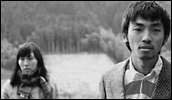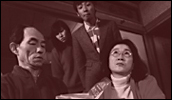No One’s Ark
- Year
- 2002
- Original title
- Baka no Hakobune
- Japanese title
- ばかのハコ船
- Director
- Cast
- Running time
- 111 minutes
- Published
- 26 September 2002



by Jason Gray
Many have lamented the current state of Japanese cinema. In fact, it's almost become fashionable to do so. The Japanese themselves are notorious for ignoring their own cinema (bested perhaps only by Canadians). This attitude often blinds people to the work that does stand out, and sometimes an entire movement. Over the last few years, a new wave of sorts has emerged from Osaka. It's the result of a collaboration between the cinema graduates of the Osaka University of Arts and distributor-cum-production company Planet Studyo+1. Notable films such as Kichiku (Kichiku Dai Enkai, 1997), Hazy Life (Donten Seikatsu, 1999), and Pornotic Night (1997) are a few of the early titles that initiated interest from international and domestic films festivals, and which later garnered theatrical releases. The directors, writers, cinematographers, actors, and musicians all work on each other's films, helping to hone their skills as a "team". No One's Ark (working title: Two Drifters) is the latest from Nobuhiro Yamashita, director of Hazy Life.
The film opens in Tokyo with a shot of a small sidewalk-stand and the hopeless efforts of the two main protagonists to sell a health drink named "Akajiru" (a play on the popular "Aojiru" product). The tone is set for the futility to come. Daisuke (Hiroshi Yamamoto) is in debt five million yen (over US$35,000) and his girlfriend Hisako (Kotera) is along for the ride down. Moments later we're "escaping" in a small motorboat heading for an unnamed, sparsely populated island. After many unsuccessful years in Tokyo, Daisuke is going home to ply his wares. He outlines his master business plan for his bewildered father and the story is on its way.
We're quickly introduced to two of Daisuke's former classmates; highly eccentric (bordering on Tourettic) grocery-store manager Ozaki (Takeshi Yamamoto) and highschool-era object of affection Madoka (Hoso), now a fuzoku (sex industry) worker. Daisuke and Hisako try to convince Ozaki to sell Akajiru through his shop, but he sees through their ploy. Next up is Daisuke's cousin, who works at a large food company with his father, but all they can present him with is a monogrammed uniform. "I'd rather fucking die than work in this place", he spits. As the odds mount against their efforts to get out of debt, we flash back to more innocent, optimistic days in the characters' lives.
The second act has Daisuke getting back "in touch" with Madoka and warming up to her pregnant, teenage sister while Hisako busily searches the island for him with Ozaki. After a brief estrangement, Ozaki secures the couple a shot to sell Akajiru in front of a large pharmacy, but it's doomed to failure. Their canned (or rather, bottled) sales enthusiasm, and the utter repetetiveness of their pitch (familiar to anyone who lives in Japan) makes it an exhausting sequence to watch. Almost inevitably, they end up giving in and giving away their entire stock for naught. Leaving the island and facing up to their financial fate is the only option ("Why doesn't she just leave him?" Western audiences might ponder).
Considering the miniscule budget and the fact it's only a second film, the technical and creative elements coalesce quite remarkably. However, it must be said that while Yamashita is responsible for the directing chores, it's Kosuke Mukai's screenplay and cinematography that are the film's charms. Much of the humour is derived from how badly the protagonists misjudge the ease of selling their rancid juice to the locals. Ozaki's verbal outbursts are numerous and amusing. The drama derives from characters who try to give good advice but won't heed it; who preach common sense to others but don't follow it themselves. In a clever aside in the one of the film's flashbacks, Daisuke pegs mid-90s phenomenon Tamagotchi as a surefire flop.
While the shooting of the interior dialogue scenes is workmanlike, the film is opened up visually and dramatically in the expansive shots of endless fields, country roads, residential outcroppings, and the quaint, bright colours of the flashbacks. In one scene where Daisuke loses face in front of everybody, his character literally deflates and crumples in front of our eyes. Toward the end, Hisako disappears down a manhole and pulls Daisuke down with her. A couple more instances of this type of visual surreality wouldn't have been out of order. Perhaps the only betrayal of the film's student origins is the very last shot. While offering a nice visual "tableau", it's a bit trite.
The soundtrack by "Aka Inu" ('Red Dog') deserves mention. It features manic surf-pop, childlike Morricone-esque minimalism, and a hilarious musical interlude which plays up the mass-marketed synthpop of the 1980s.
A final recommendation for the film: as half of the team who did the English subtitles for No One's Ark, I had to view it four or five times during the translation process. My initial response was quite cool, but as I watched more I warmed to the film's idiosyncratic characters, the simple yet carefully framed cinematography, and the small touches of period detail. I'd like to meet these characters again further down the road, and I wish them well.